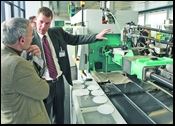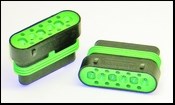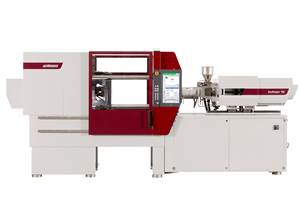First Foamed LSR Molding Uses Direct Gas Injection
Updated horizontal and vertical presses and robots were some of the attractions at the annual conference and technical exhibition of Arburg GmbH in Lossburg, Germany.
Updated horizontal and vertical presses and robots were some of the attractions at the annual conference and technical exhibition of Arburg GmbH in Lossburg, Germany. This year’s event marked the company’s 50th anniversary selling injection machines, celebrated with a “Golden Edition” press series. In addition, Arburg and several industry partners unveiled a significant innovation—foam molding of liquid silicone rubber (LSR)—and showed off an interesting new application of thermoplastic/LSR overmolding in a single tool.
Equipment update
In addition to five models of its new Allrounder C Golden Edition 50th-anniversary machines (re ported here in April), Arburg also demonstrated its new Allrounder 175 V, its first standard fixed-table vertical-clamp insert molder (Arburg also has a rotary-table T Series). Introduced last fall, the unit has a 15-ton C-frame clamp and either vertical or horizontal injection. It can mold parts from 1 to 40 g of PS.
In the view of Arburg officials, the highlight of the technology exhibit was a high-speed demonstration of the all-electric Allrounder 420A Alldrive. It molded two 8.6-g PP cups in a 2.2-sec cycle. That included an “extra” 0.3 sec to allow for robot take-out.
Speaking of robots, Arburg now offers its Multilift V traversing units for larger presses in the more compact single-beam version that is already available for smaller machines. Previously, only a dual-beam gantry style was offered for Allrounder 630S, 720S, and 820S machines of 250 to 400 metric tons. The servo-electric robot can carry up to 55 lb and boasts positioning accuracy to ±0.1 mm and speeds up to 4000 mm/sec on its main axes.
Leading-edge LSR
Arburg hosted a demonstration of a new processing technique that for the first time allows foaming of LSR during injection molding. Developed by Sulzer Chemtech AG in Switzerland, the Optifoam technique adds nitrogen or CO2 under pressure (1450 to 2900 psi) to both LSR components through metering units connected to each material feed line. Introducing the gas in a “supercritical” state enables the gas to diffuse fully into the LSR materials.
The gas-loaded LSR components come to gether in a special static-mixing manifold before entering the mold. “The static mixer is three to four times better than screw mixing, and it homogenizes with low shear forces,” says Joachim Studlek, manager of plastic processing, mixing, and reaction technology at Sulzer Chemtech Germany. Uniform distribution of gas into the material reportedly results in uniform foam cells.
Sulzer developed a special nozzle to prevent premature foaming in the barrel. Foaming occurs during injection as soon as the pressure is released. The mold requires an optimized venting system to allow gas to escape.
Foaming LSR reportedly can provide 30% to 60% weight reduction. Unfoamed LSR has a density of 1.1 g/cc, which can be reduced to 0.45 g/cc. Foaming also lowers Shore hardness by up to 50%, which gives a softer feel.
At Arburg, sample foam parts were molded using a delivery system from 2 Komponenten Maschinenbau (which has a Canadian office), a gas-delivery system from Maximator, specially optimized LSR materials from Dow Corning, a mold from Edegs-Formenbau, and an Arburg Allrounder 420 C 1000-250 hydraulic press with a special LSR barrel. The partners in the project have been working on LSR foaming since 2005.
A second interesting LSR demonstration at Arburg involved a two-zone mold with a rotating core that allows overmolding a thermoplastic (PBT) with LSR in one machine. The basic technology is not new, but the part design was more complex than usual, involving LSR overmolding in two places. The part is a six-pin electronic connector of 30% glass-filled PBT with an LSR insert in the connector face at one end and an LSR ribbed seal around the middle of the part (see photo).
The 4+4 cavity mold was built by Rico Elastomere Projecting GmbH in Austria. When the mold opens, the core-insert plate extends, rotates, and retracts; then the mold closes. The drive for the insert plate is integrated into the mold so that it can be used on other machines. Both components are produced with a “live” sprue for waste-free part production. Says Rico president Gerhard Kornfelder, “Liquid silicone requires a cold runner (around 77 F) and a hot mold (392 F), while the PBT uses a hot runner (572 F) and a “cold” mold (212 F).” The two zones are thermally isolated from each other.
Rico’s mold was mounted in an Arburg Allrounder 470 U with a vertical injection unit for the main thermoplastic component and a horizontal injector for the LSR. This configuration ensured easy access to the silicone feed. The part was molded in fully automatic operation with a cycle time of approximately 30 sec.
Related Content
Silicone Elastomer Course Returns
After completely filling the classroom last year, the Silicone Elastomers Technology and Fabrication course returns to Pomona, Calif. Jan. 31-Feb. 3.
Read MoreCompletely Connected Molding
NPE2024: Medical, inmold labeling, core-back molding and Industry 4.0 technologies on display at Shibaura’s booth.
Read MoreFakuma 2023: Wittmann Battenfeld Expands All-Electric Line, Direct-Current Capabilities
Wittmann Battenfeld will introduce the new EcoPower B8X injection molding machine line and show direct current as an energy source for a concept machine that will power its own robot.
Read MoreDatwyler Expands O-Ring Production
The company has added injection molding machines to production sites in Mexico and China to boost production.
Read MoreRead Next
See Recyclers Close the Loop on Trade Show Production Scrap at NPE2024
A collaboration between show organizer PLASTICS, recycler CPR and size reduction experts WEIMA and Conair recovered and recycled all production scrap at NPE2024.
Read MoreFor PLASTICS' CEO Seaholm, NPE to Shine Light on Sustainability Successes
With advocacy, communication and sustainability as three main pillars, Seaholm leads a trade association to NPE that ‘is more active today than we have ever been.’
Read More














